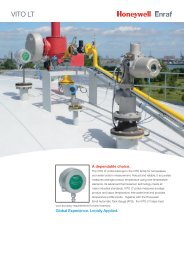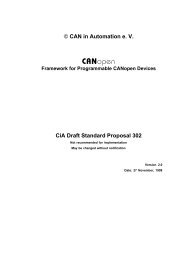118_4416655_Rev06
You also want an ePaper? Increase the reach of your titles
YUMPU automatically turns print PDFs into web optimized ePapers that Google loves.
Appendix<br />
___________________________________________________________________________<br />
Situation 2 (probe fully covered with product)<br />
Read the measured capacitance by item MX.<br />
Enter this value into item VR.<br />
Situation 3 (probe partly covered by water and partly covered by product)<br />
Check the water level by means of a manual measurement.<br />
An interpolation is applied on the measured capacitance to find the capacitance value at zero water level.<br />
Refer to figure: manual measurement of water level.<br />
The interpolation of the capacitance value is done as follows:<br />
Round off the % water value to 0.1%.<br />
To calculate the value for item VR (minimum capacitance), the actual<br />
measured capacitance (item MX) and the maximum capacitance (item VT)<br />
should be known. These two values can be read by the PET or via the<br />
service program from the instrument.<br />
The minimum capacitance value is then calculated as follows:<br />
For example:<br />
Water level (measured by manual dip)<br />
= 0.122 m (or 4.80 inch or 0.400 ft)<br />
WB = 0.025 m (or 0.98 inch or 0.082 ft)<br />
MX = 185.224 pF<br />
VT = 430.4 pF (obtained from “CheckList<br />
765/766/768 Final Assembly”)<br />
Manual measurement of water level<br />
Step 1:<br />
% water (rounded off to 0.1%):<br />
Instruction manual VITO Page 45







